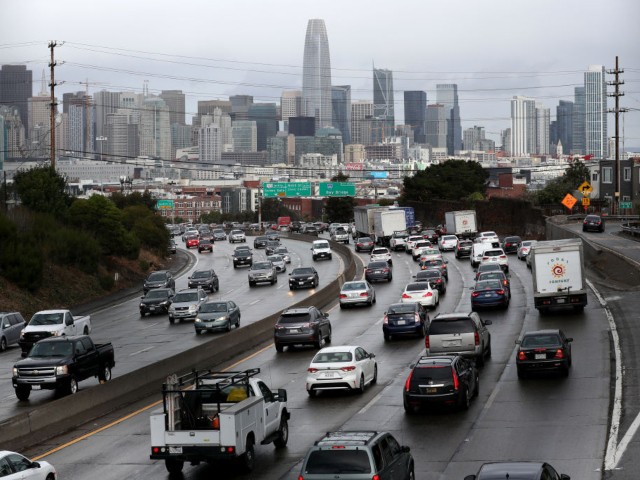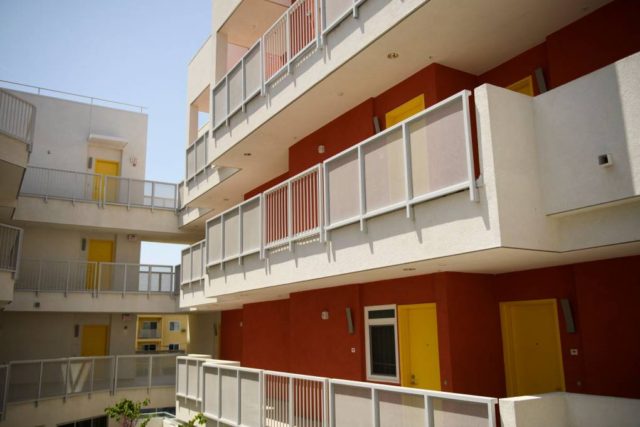A pillar of the American Dream is under assault across the country, but nowhere is it more pronounced than in California where social justice activists and Democrat Gov. Gavin Newsom are invading single-family home neighborhoods with plans to replace them with multi-unit properties.
A brochure for a San Diego neighborhood in the 1950s highlighted why families flocked to the suburbs: “More luxury at lower cost,” “private and protected,” “beauty and convenience.”
Add to that safety from urban crime, and Americans embraced this part of the Dream by the millions.
“It was a California fantasy,” the New York Times said of Clairemont Villas. “Over six colorful pages the brochure sold buyers on an indoor-outdoor lifestyle where the living room opened to a yard and children played behind a redwood fence.”

California Gov. Gavin Newsom speaks to union workers and volunteers on election day at the IBEW Local 6 union hall on September 14, 2021, in San Francisco, California. (Photo by Justin Sullivan/Getty Images)
But now that dream is unraveling, spelled out graphically the Times piece:
Two days after surviving a California recall election, Gov. Gavin Newsom signed Senate Bill 9. By legalizing duplexes statewide and allowing people to subdivide single-family lots, S.B. 9 effectively ended single-family zoning in a state of 40 million whose identity is predicated on the suburban idyll.
Cities have lost most of their power to prevent backyard units from being built, and state legislators have tried to speed construction by reducing development fees, requiring cities to permit them within a few weeks and prohibiting local governments from requiring dedicated parking spots. In contrast to the battles over S.B. 9 — this year’s duplex law, which was branded a bill of “chaos” that would “destroy neighborhoods” and be “the beginning of the end of homeownership in California” — the A.D.U. laws passed with no comparable controversy.
Last year, San Diego’s City Council voted unanimously to expand on state law by allowing bonus units, sometimes as many as a half-dozen per lot, if a portion are set aside for moderate-income households. Development has exploded on cue. California cities issued about 13,000 permits for accessory units in 2020, which is a little over 10 percent of the state’s new housing stock and up from less than 1 percent eight years ago. The effect is already visible throughout Southern California: four-unit buildings rising behind one-story bungalows; prefabricated studio apartments being hoisted into backyards via crane; blocks where a new front-yard apartment sits across the street from a new backyard apartment down the way from a new side-yard apartment.
And the radical transformation of the state’s housing landscape is actually enriching developers as it forces people to live in more crowded conditions.
The Times profiled Christian Spicer, a longtime house-flipper who is taking advantage of the “backyard boom.”
Spicer’s company bought a house in Clairemont Villas for $700,000. Spicer estimates the house would rent for $3,300 a month with a few improvements. But he decided to spend about $400,000 building the new units and splitting the house and believes he will now get between $9,000 and $10,000 a month in rent.
That return would increase the property’s value to about $1.7 million.

Traffic moves along U.S. Highway 101 towards downtown San Francisco on November 27, 2019, in San Francisco, California. (Photo by Justin Sullivan/Getty Images)
“The price would be galling to an aspiring homeowner who might have outbid another family before losing to Mr. Spicer and now feels cheated out of the American dream,” the Times reported. “But of course the 10 to 12 people who move in are unlikely to think the world would be better off if their homes had remained dirt and only one family lived there.”
“Housing is complicated,” the Times said in its biased piece.
Reforming housing will solve “existential problems,” the Times claimed, including allegedly reducing segregation, wealth inequality, combating sprawl, and fighting climate change.
“But the process will be long and difficult, as single-family neighborhoods are America’s predominant form of living and homeowners broadly enjoy them,” the Times reported.
Cary Gross, 63, owns a tile company and lives in Clairemont Villas. He bought a home there 25 years ago with the expectation that it would stay that way.
“They say they’re doing this so everyone can have the American dream,” he said. “But what about the American dream of living in a single-family neighborhood?”
Follow Penny Starr on Twitter or send news tips to pstarr@breitbart.com.

COMMENTS
Please let us know if you're having issues with commenting.